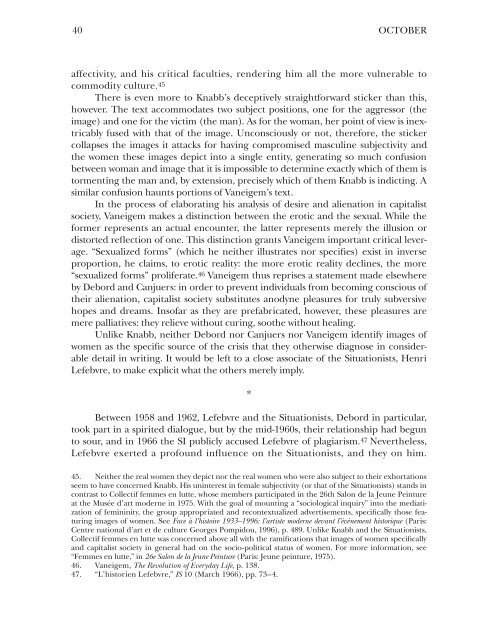The Sex of the Situationist International* - 1000 Little Hammers
The Sex of the Situationist International* - 1000 Little Hammers
The Sex of the Situationist International* - 1000 Little Hammers
Create successful ePaper yourself
Turn your PDF publications into a flip-book with our unique Google optimized e-Paper software.
40<br />
affectivity, and his critical faculties, rendering him all <strong>the</strong> more vulnerable to<br />
commodity culture. 45<br />
<strong>The</strong>re is even more to Knabb’s deceptively straightforward sticker than this,<br />
however. <strong>The</strong> text accommodates two subject positions, one for <strong>the</strong> aggressor (<strong>the</strong><br />
image) and one for <strong>the</strong> victim (<strong>the</strong> man). As for <strong>the</strong> woman, her point <strong>of</strong> view is inextricably<br />
fused with that <strong>of</strong> <strong>the</strong> image. Unconsciously or not, <strong>the</strong>refore, <strong>the</strong> sticker<br />
collapses <strong>the</strong> images it attacks for having compromised masculine subjectivity and<br />
<strong>the</strong> women <strong>the</strong>se images depict into a single entity, generating so much confusion<br />
between woman and image that it is impossible to determine exactly which <strong>of</strong> <strong>the</strong>m is<br />
tormenting <strong>the</strong> man and, by extension, precisely which <strong>of</strong> <strong>the</strong>m Knabb is indicting. A<br />
similar confusion haunts portions <strong>of</strong> Vaneigem’s text.<br />
In <strong>the</strong> process <strong>of</strong> elaborating his analysis <strong>of</strong> desire and alienation in capitalist<br />
society, Vaneigem makes a distinction between <strong>the</strong> erotic and <strong>the</strong> sexual. While <strong>the</strong><br />
former represents an actual encounter, <strong>the</strong> latter represents merely <strong>the</strong> illusion or<br />
distorted reflection <strong>of</strong> one. This distinction grants Vaneigem important critical leverage.<br />
“<strong>Sex</strong>ualized forms” (which he nei<strong>the</strong>r illustrates nor specifies) exist in inverse<br />
proportion, he claims, to erotic reality: <strong>the</strong> more erotic reality declines, <strong>the</strong> more<br />
“sexualized forms” proliferate. 46 Vaneigem thus reprises a statement made elsewhere<br />
by Debord and Canjuers: in order to prevent individuals from becoming conscious <strong>of</strong><br />
<strong>the</strong>ir alienation, capitalist society substitutes anodyne pleasures for truly subversive<br />
hopes and dreams. Ins<strong>of</strong>ar as <strong>the</strong>y are prefabricated, however, <strong>the</strong>se pleasures are<br />
mere palliatives: <strong>the</strong>y relieve without curing, soo<strong>the</strong> without healing.<br />
Unlike Knabb, nei<strong>the</strong>r Debord nor Canjuers nor Vaneigem identify images <strong>of</strong><br />
women as <strong>the</strong> specific source <strong>of</strong> <strong>the</strong> crisis that <strong>the</strong>y o<strong>the</strong>rwise diagnose in considerable<br />
detail in writing. It would be left to a close associate <strong>of</strong> <strong>the</strong> <strong>Situationist</strong>s, Henri<br />
Lefebvre, to make explicit what <strong>the</strong> o<strong>the</strong>rs merely imply.<br />
*<br />
OCTOBER<br />
Between 1958 and 1962, Lefebvre and <strong>the</strong> <strong>Situationist</strong>s, Debord in particular,<br />
took part in a spirited dialogue, but by <strong>the</strong> mid-1960s, <strong>the</strong>ir relationship had begun<br />
to sour, and in 1966 <strong>the</strong> SI publicly accused Lefebvre <strong>of</strong> plagiarism. 47 Never<strong>the</strong>less,<br />
Lefebvre exerted a pr<strong>of</strong>ound influence on <strong>the</strong> <strong>Situationist</strong>s, and <strong>the</strong>y on him.<br />
45. Nei<strong>the</strong>r <strong>the</strong> real women <strong>the</strong>y depict nor <strong>the</strong> real women who were also subject to <strong>the</strong>ir exhortations<br />
seem to have concerned Knabb. His uninterest in female subjectivity (or that <strong>of</strong> <strong>the</strong> <strong>Situationist</strong>s) stands in<br />
contrast to Collectif femmes en lutte, whose members participated in <strong>the</strong> 26th Salon de la Jeune Peinture<br />
at <strong>the</strong> Musée d’art moderne in 1975. With <strong>the</strong> goal <strong>of</strong> mounting a “sociological inquiry” into <strong>the</strong> mediatization<br />
<strong>of</strong> femininity, <strong>the</strong> group appropriated and recontextualized advertisements, specifically those featuring<br />
images <strong>of</strong> women. See Face à l’histoire 1933–1996: l’artiste moderne devant l’événement historique (Paris:<br />
Centre national d’art et de culture Georges Pompidou, 1996), p. 489. Unlike Knabb and <strong>the</strong> <strong>Situationist</strong>s,<br />
Collectif femmes en lutte was concerned above all with <strong>the</strong> ramifications that images <strong>of</strong> women specifically<br />
and capitalist society in general had on <strong>the</strong> socio-political status <strong>of</strong> women. For more information, see<br />
“Femmes en lutte,” in 26e Salon de la Jeune Peinture (Paris: Jeune peinture, 1975).<br />
46. Vaneigem, <strong>The</strong> Revolution <strong>of</strong> Everyday Life, p. 138.<br />
47. “L’historien Lefebvre,” IS 10 (March 1966), pp. 73–4.



